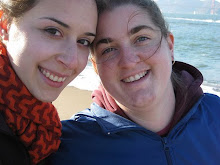
Turns out olive harvesting is painful. At least, if you're the one up the tree it is. Maybe I should post pictures of my myriad scratches and scrapes. :)
However, we had a great week in the far North of NZ with Charlotte, Mark, and Joe! They're a charming family of mixed British and Kiwi descent who just moved onto this farm about a year ago. Mark is a general practitioner in the nearby town, Charlotte is a farmer-mom and baker extraordinaire, and Joe is an energetic, bright 4-year old. They had no previous experience with olive farming, sheep, veggie growing, or anything of the sort, but over the last year they've been learning as they go and fixing up this farm into a really great place. There are some 600 olive trees scattered all over the property, often in the most inaccessible spots. We didn't harvest all of them, as some were chock full of olives and others only had sparse smatterings. It took some ingenuity to figure out how to get at them. The method we mostly relied on was spreading large nets on the ground under several trees at a time, propping up the parts where the olives might roll down the hill and get lost in the pasture. Then we used hands and small rakes to strip olives from the twigs.

Of course, the best and blackest olives always seemed to be on the very top of the trees, which necessitated some serious monkey-climbing into the precarious upper-branches. None of these trees were really large, and in many of them the breeze coming in off the harbor would send branches (and the harvester perched among them) swaying to and fro. Mark compared it to "Crouching Tiger, Hidden Dragon". I've always been an avid tree climber, and it was a lot of fun to squirm up through the branches and pull down handfuls of olives, with just my legs braced against anything steady. The only drawback was the abundance of tiny twigs smacking you in the face, scratching at arms and legs, and snagging clothing. But still fun.
 This summer there's been a pretty terrible drought up in that region, with absolutely no rainfall for about 4 1/2 months straight. After last year's bumper crop, the trees this year could hardly compete. However, by the end of our 3 straight days of picking we had filled up every available container, from olive baskets to Joe's toy containers, to shopping bags and coolers. Charlotte and Mark told us they expect the olives to yield a great amount of oil for their weight, as they're not filled up with any excess water. It should be particularly good oil as well. Mark drove our load to the nearest olive press on Sunday night, so hopefully in the next couple of days well know the final weight of our harvest, and what kind of rating their oil receives.
This summer there's been a pretty terrible drought up in that region, with absolutely no rainfall for about 4 1/2 months straight. After last year's bumper crop, the trees this year could hardly compete. However, by the end of our 3 straight days of picking we had filled up every available container, from olive baskets to Joe's toy containers, to shopping bags and coolers. Charlotte and Mark told us they expect the olives to yield a great amount of oil for their weight, as they're not filled up with any excess water. It should be particularly good oil as well. Mark drove our load to the nearest olive press on Sunday night, so hopefully in the next couple of days well know the final weight of our harvest, and what kind of rating their oil receives. When we weren't harvesting we helped Charlotte mulch her veggie garden, harvest apples from their couple of trees, feed the sheep, read to and entertain Joe, etc. He's a really funny kid, always eager to be in the thick of the action. He would don his Batman and Spiderman costumes and bring us cold beers or lunches while we were harvesting. And do break dancing and The Robot performances for us. They had an amazing cat named Lola, who followed us as we went around the property, pounced and jumped after the rugby ball when we played with Joe, and alternately attacked us and snuggled with us. I think Kelly fell in love with her.
When we weren't harvesting we helped Charlotte mulch her veggie garden, harvest apples from their couple of trees, feed the sheep, read to and entertain Joe, etc. He's a really funny kid, always eager to be in the thick of the action. He would don his Batman and Spiderman costumes and bring us cold beers or lunches while we were harvesting. And do break dancing and The Robot performances for us. They had an amazing cat named Lola, who followed us as we went around the property, pounced and jumped after the rugby ball when we played with Joe, and alternately attacked us and snuggled with us. I think Kelly fell in love with her. We spent one morning wandering the beach where their property meets the Hokianga Harbor. There are great big boulders scattered around the shore, with oysters crusted all over them and little black crabs with blue claws scuttling away into the crevices when we approached. On Monday Charlotte lent us her car so we could take a drive to scenic Waimamaku Beach and the South Head at the entrance to the Harbor.
Overall a fun, busy, exhausting week up North. This kind of personal experience has really been more meaningful to us than a lot of the sights we've seen around the country. Now we're back in Auckland figuring out our next move. I think we'll be heading back to the States sometime soon.

